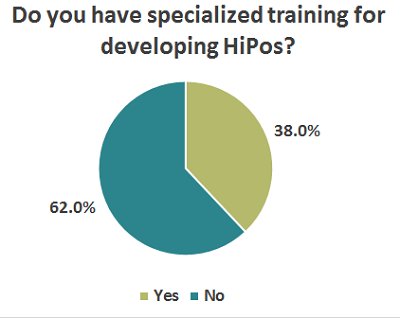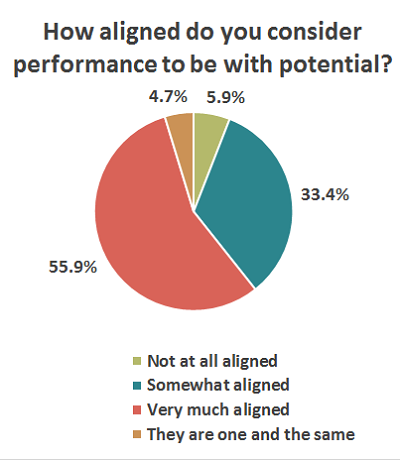Talent Management

55.3% of respondents make use of succession planning, and 51.1% use talent pipelines as talent management strategies. 39% of survey takers said that they make use of talent pools, and 34.4% make use of talent inventories as part of their talent management strategies. The majority of “other” responses (8.5%) answered that they don’t use any talent management strategies.
Want to make sure you are getting the right person for the job? Start on Wednesday, November 18, 2015, with a new interactive webinar—Hiring Mr. or Ms. Right: Best Practices on Using Strategic Talent Assessments. Learn More
Succession Planning

When asked how important succession planning is to our survey takers, the overwhelming majority (90.5%) found it to be at least “important” (24%), “very important” (42.5%), or “extremely important” (24%). Only 7.8% said it is “somewhat important” and a mere 1.8% said it is “not at all important.”
Succession planning may be important to nearly all of the survey takers, but 46% of respondents say they manage succession planning by dealing with vacancies as they arise—in other words, they don’t actually have a plan. 30.3% said, “We have a plan for critical roles within our organization.” Only 7.1% said, “We have a contingency for every potential vacancy,” and the same percentage (7.1%) said they have a complete map of several specific individuals who can take over any vacancy at any time. 7.1% answered “other,” and some of those “other” responses include:
- “Turnover is low (1%), so current focus is more on prep for retirement.”
- “Company doesn’t have a system yet, we are building it.”
- “We are in the development stage of planning.”
- “While we have plans for many critical positions, we do not have plans for all such positions.”
Performance Reviews and Succession Planning

Most respondents said that they use performance reviews as a general model for how HiPos would work in any particular vacancy (38.1%), or that they don’t connect performance reviews to their succession plans (28.6%). 22.6% said that they explicitly use performance reviews as a measure of employee potential while planning succession. Only 5% of respondents said that they use performance reviews to settle disagreements as to who should fill a particular vacancy. Only 5.7% of respondents answered “other.”
Training HiPos

When asked “Do you have specialized training for developing HiPos?” only 38% of the respondents said that they do, while the majority (62%) said that they don’t. We also asked them to specify what kind of specialized training they provide. The number one response was “in-house mentorship” at 59.6%. The next three were all very similar, with 50.4% saying that they use “company-operated leadership training,” 48.9% saying they use “outside or consultant coaching/leadership training,” and 48.9% saying they use “additional skills or jobs training.” 13.5% answered “other,” and here are some of those responses:
- “I’m not given authority to address this.”
- “HR has begun using development plans monthly.”
- “Opportunities for classes for certification in specific disciplines.”
- “A training program lead by existing executives and managers to prepare them for the next step.”
The Relationship Between Performance and Potential

It’s clear that participants find performance and potential to be similar or connected. When participants were asked what they perceived to be the relationship between performance and potential, the majority (55.9%) said that they considered it to be “very much aligned.” 33.4% said it is “somewhat aligned.” The more extreme answers both got low responses, with “not at all aligned” selected by 5.9% of respondents, and “they are one and the same” selected by 4.7%.
Participants
A total of 406 individuals participated in this survey, which was conducted in September 2015. At 40.9%, managers made up the largest portion of the respondent pool. A little less than one-third of participants (29.2%) identified as executives (i.e., VP level or higher), and staff-level employees made up 7.6% of those surveyed. The smallest group represented (at 6.3%) was comprised of supervisors.
Of those who identified themselves, the majority (61.7%) represent privately owned, for-profit companies; 17.9% are employed by nonprofits; 9.4% work in the public sector; and government organizations were represented by 11.0% of the response pool.
Our respondents represented a large variety of industries, with the largest four industries being health care and social assistance (11.4%); manufacturing (16.9%); professional, scientific, technical services (11.4%); and finance and insurance (10.7%).
There was a pretty good spread among the sizes of companies involved, with 18.4% of participants from companies with 101–250 employees, 17.1% from those with 1–50 employees, 17.1% from those with 251–500 employees, 15.5% from those with 51–100 employees, and 13.5% from those with 1,001–5000 employees. 9.4% of those responded were from companies with 501–1000 employees, and 9% from those with over 5,000 employees.
If you want to hire a HiPo, it makes sense to consider talent assessments. With the battle for talented employees intensifying, more companies are implementing them. Fortunately there’s timely help in the form of BLR’s new webinar—Hiring Mr. or Ms. Right: Best Practices on Using Strategic Talent Assessments. In just 90 minutes, on Wednesday, November 18, you’ll learn everything you need to know about strategic talent assessments.
Register today for this interactive webinar.
Want to hire a keeper? Join us Wednesday, November 18, 2015, for a new interactive webinar, Hiring Mr. or Ms. Right: Best Practices on Using Strategic Talent Assessments. Earn 1.5 hours in HRCI Recertification Credit and 1.5 hours in SHRM Professional Development Credit. Register Now
By participating in this interactive webinar, you’ll learn:
- Why strategic talent assessments benefit your organization and why successful companies use them in a competitive hiring market
- What types of assessments are out there — and steps to making the right decision
- When to use a comprehensive approach to determine the climate of the organization
- When to alter approaches for the multiple skills and competencies needed in an organization
- How to use talent assessments to gauge leadership qualities
- How to avoid assessments that may be interpreted as discriminatory in any way
- And much more!
Register now for this event risk-free.
Wednesday, November 18, 2015
1:30 p.m. to 3:00 p.m. (Eastern)
12:30 p.m. to 2:00 p.m. (Central)
11:30 a.m. to 1:00 p.m. (Mountain)
10:30 a.m. to 12:00 p.m. (Pacific)
Approved for Recertification Credit and Professional Development Credit
This program has been approved for 1.5 credit hours toward recertification through the Human Resource Certification Institute (HRCI) and 1.5 credit hours towards SHRM-CPSM or SHRM-SCPSM.
Join us on Wednesday, November 18, 2015—you’ll get the in-depth Hiring Mr. or Ms. Right: Best Practices on Using Strategic Talent Assessments webinar AND you’ll get all of your particular questions answered by our experts.
Train Your Entire Staff
As with all BLR®/HR Hero® webinars:
- Train all the staff you can fit around a conference phone.
- Get your (and their) specific phoned-in or e-mailed questions answered in Q&A sessions that follow the presentation.
